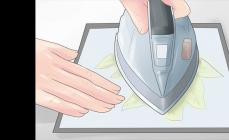Photo: Gennadiy Kravchenko/Rusmediabank.ru
A tattoo is a piquant way to attract male attention, which is used by many women. Alas, what adorns the body at the age of 20 does not always look as great at the age of 40. A tattoo does not fit into the image of a business woman, and sometimes even undermines it. Piercings in the tongue or navel are a turn-on for young guys and can easily turn off older men. Fortunately, advances in cosmetology allow you to get rid of permanent patterns and piercings on your body.The most painful and oldest method of removal is surgery. By the way, it is also the most traumatic: after the operation, scars will remain in place of the previous pattern, which no laser will hide. Under general anesthesia, the surgeon cuts off the piece of skin on which you once wanted to imprint the design you liked. Healing takes at least a month - you will have to daily lubricate the cut site with an antiseptic and apply an elastic bandage.
An ugly scar may remain after cryosurgery. Using tweezers and a cotton pad, the dermatologist covers the entire tattoo with a liquid nitrogen solution. The resulting thermal burn becomes crusty. It will disappear in about 2-3 weeks.
The most bloodless way to reduce an image is camouflage. The area of skin is numbed with lidocaine and treated with a needle with a flesh-colored dye. The dye can cause severe allergies, so a qualified cosmetologist will definitely do a test before the procedure. The sensations, of course, are not the most pleasant, but beauty requires sacrifice. A significant disadvantage of camouflage is the small processing area (the tattoo should occupy an area of no more than 5*5 cm). After undergoing the procedure, be prepared to leave the contours of the tattoo untouched. Are you not happy about the prospect of walking around with a whitening image on your shoulder or hip for several months? Use sunscreen on the beach.
Camouflage can also be called applying a new design to a previous tattoo. You will like this idea if you are not against the design on the skin in principle, but want to hide a provocative inscription such as the name of an ex-boyfriend. At your request, the tattoo artist will hide the memories of your turbulent youth with a floral ornament or an ethnic pattern.
A modern method of tattoo removal without scars and pain - laser correction. To completely get rid of the pattern, a minimum of 5-6 sessions will be required. The laser beam evaporates color pigments and damaged epidermis, leaving pink skin at the tattoo site. Depending on the cabin level, one beam or a whole beam can be used at the same time. The green laser eliminates yellow, green and blue dyes. Purple – red, orange and black. The break between corrections usually takes from 2 to 4 weeks. During the recovery period, antibiotics are indicated to prevent suppuration and eczema. Typically, a dermatologist recommends additional therapy in the form of peeling with fruit acids and anti-scarring ointment.
Opportunity removing a hole from a piercing depends entirely on how professionally the puncture was performed and whether you looked after it correctly. At least six months should pass between release from the ring and treatment. During this period, try to help the hole heal on its own. Twice a day, lubricate the piercing area with Contractubex and wipe with salicylic acid lotion. To speed up reparative processes in the epidermis, intensively massage the skin with a mixture of sea salt and thick sour cream three times a week. Good results are obtained with vitamin E oil extract. The only condition is that hands must be thoroughly washed with soap before massage manipulations. Remember how you washed your earring while swimming? Treat an open piercing the same way.
Has the puncture healed within six months? Then it makes sense to turn to traditional medicine. Expensive option - Plastic surgery. Most often, young mothers who wore a ring in their navel resort to it. During pregnancy, the skin on the abdomen stretches, and at the site of a small puncture, a large scar appears, surrounded by a “mesh” of stretch marks.
The first stage of splicing is microdermabrasion. It stimulates the production of collagen, which is necessary for the natural removal of the puncture. A couple of days after laser resurfacing, the surgeon will sew up the hole. In its place there will only be a micro-suture, and even that will resolve after a while.
The most problematic places for piercing are the eyebrow and tongue. Before you decide on an extravagant experiment with your own appearance, think about whether you will make people around you laugh in five years.
Despite the fact that piercing removal is not a common procedure, it is necessary to do it sometimes. There may be several reasons why you need to remove a piercing, but in any case you should follow the rules.
How to remove jewelry from the body
There are two ways to do this: on your own or contact a piercer with such a request. If you have to resort to self-removal, you must carefully monitor the sterility of your hands. The subsequent healing of the piercing mark depends on this. If an infection gets there, healing will be long and painful.
You need to do the following:
- Wash your hands thoroughly with soap and water.
- Remove jewelry depending on its type. If you need to remove the ring, you will have to bend it with special pliers. If you have to remove a stud-shaped decoration, you shouldn’t do it yourself. There is a risk of the fixative getting into the nasal passage, and this is already dangerous.
- If there is a need to replace the jewelry with a new one, you should do this quickly, before the hole closes. Therefore, you need to prepare new jewelry in advance and put it on the table.
In some cases, it is impossible to do without seeking outside help. This applies to cases of complex jewelry that must be removed very carefully. Also, in the case of ingrown piercings, surgical intervention is required. In this case, you will have to contact specialists.
Healing a piercing mark
After removing the piercing, it is necessary to treat the hole with saline solution and boiled water. Over time, the hole will close on its own, gradually decreasing in size. To make the hole heal faster, you can use an oil solution of vitamin E, massage the area around the hole, and use special ointments to get rid of scars. All these measures must be taken only with clean hands.
You should not make hasty conclusions about the condition of the piercing if six months have not passed since the piercing was removed. This is how long it takes for complete tissue fusion. There are times when it is so large that it cannot close on its own. In this case, you will have to seek help from a surgeon.
Before carrying out the procedure of piercing body parts for piercing, you need to carefully weigh all the arguments. Sometimes this is done as a result of emotional impulses in pursuit of fashion. Over time, the attitude towards such jewelry changes, but the scars on the body remain.
If you are on this page, it means that either something has already gone wrong for you, or you are a great fellow and are thoroughly preparing for the piercing procedure. And here’s the first thing you need to know: if there’s something wrong with your piercing, immediately report it to your master.
But sometimes it happens that he is out of reach, or completely lost - this also happens. Nevertheless, the problem must be solved somehow. We have collected for you the most common problems and complaints of piercing owners - with a ready-made solution.
And remember: if you fail to return everything to normal on your own, our specialists will always offer you an examination and consultation.
Pimple in the puncture area

Symptoms:
- appears periodically or once small and red, slightly swollen pimple near the puncture, local inflammation;
- may appear itching or burning, sometimes the pimple is painless;
- when pressed, releases pus and/or blood
Treatment:
- treat with antiseptic + antihistamines medications that will help reduce itching and inflammation;
- do several times a day G hot salt compresses or wipe with saline solution. Continue doing them for 2-3 weeks after the problem seems to be resolved;
- relapse indicates the presence pathogenic microorganisms, in such a situation it is better to consult a dermatologist.
Keloid scars

It must be said that keliodes are rarely found in northern people, most often in pregnant women and black people. Keloids are often confused with granulomas. The difference is that a keloid is usually much larger than the decoration in the piercing.
Symptoms:
- skin growths are red, often painful, but large;
- most often appear in places where the navel is pierced, nostrils, lips, intimate piercings. Also also occurs when other types of piercing a.
Treatment:
- this cannot be done without medical intervention. A dermatologist should determine which method is best for you - such as cauterizationliquid nitrogen or surgical excision.
Piercing displacement/rejection
 Symptoms:
Symptoms:
- the piercing “moves”, rises close to the surface of the skin, the jewelry is “pushed” out of the puncture channel;
- the skin between the punctures turns red, peels, or, on the contrary, looks like a callus and becomes thinner.
Treatment:
- Most likely, the piercing was done incorrectly from the beginning. This often happens with planar piercings, which require a lot of experience. In this case, you should take out the jewelry, wait for the canal to heal and get a new piercing from another master;
- Navel piercing migration is common during pregnancy. In this case, it makes sense to remove the jewelry and make a new piercing after childbirth;
- if the previous two options are not suitable, two more remain: either the decoration is unsuitable, or care wrong. In any case, you will have to part with the “beauty”, wait for healing and get a new puncture from a specialist who will tell you everything about the care and choose the right jewelry.
Unpleasant odor when the nose is pierced (nostil, septum)
Sometimes people complain of an unpleasant "cheesy" smell after a nose piercing - the problem most often occurs with a septum piercing. The “amber” is felt especially intensely if you wrinkle your nose or move it. Typically the problem occurs in four cases:
- this phenomenon is part of the healing process, and a few days after the puncture it goes away on its own;
- Most likely, the jewelry is made of medical steel or other materials that can cause allergies. In this case, it is advisable to replace the decoration;
- you do not properly care for the piercing, and the smell is the consequences of such a mistake. Once again, clarify how to wash the piercing + add daily hygienic washing with soapy water;
There is another option: you simply have a heightened sense of smell, and the smell will haunt you all the time. This also happens. In this case, whether to refuse a puncture or not is up to everyone to decide for themselves.
Non-healing puncture, hence: discharge from the canal,
constant redness, etc.
 Almost any piercing takes at least 3-6 months to heal. The healing period is greatly influenced by factors such as accidental or permanent damage to the canal.and (sometimes after them, healing even begins anew), the quality of puncture processing, the quality of decoration, the location of the puncture andthe quality of the piercer's work.
Almost any piercing takes at least 3-6 months to heal. The healing period is greatly influenced by factors such as accidental or permanent damage to the canal.and (sometimes after them, healing even begins anew), the quality of puncture processing, the quality of decoration, the location of the puncture andthe quality of the piercer's work.
Usually the reason lies in one of the above. For example, you put microdermals on your shoulders, but started wearing a backpack - and they can “heal” for years. Using the method of elimination, find the cause and eliminate it. You paid money for the puncture - and the master should help you solve the problem. If he behaves differently, look for a new master (preferably based on reviews from friends).
Blow out
This is a cunning consequence of tunnels that does not interfere with life, but looks ugly. It looks like a growth of excess skin along one of the sides of the tunnel.
It usually appears due to improper stretching, when part of the lobe is constantly tense (usually scar tissue, since it does not stretch), and the rest in the same place is relaxed.
It can only be treated with a scalpel, threads and the hands of a good master.
It's completely normal for the piercing to heal...
- And Change in skin color near the puncture: It may become reddish, brownish or pinkish for several months;
- slight swelling and/or hardening may be observed for several days after lip or tongue piercing;
- The puncture may release a small amount of clear fluid, dead cells that form a crust on the surface of the piercing. In this case, the discharge should not be abundant, green, yellow or have an odor;
Remember, that…
- you cannot solve the problem by simply taking out the jewelry and waiting - the problem always lies deeper;
- Most often, the problem can be solved by simply changing the decoration, its shape or size.
You should immediately run to your piercer if...
- profuse green or yellow discharge with an unpleasant odor flows from the puncture;
- some of the symptoms described in the first part last longer than a week;
If you have started fever, chills, nausea, vomiting, dizziness or disorientation - run to the doctor.
BUT!
Remember that most problems arise due to the inexperience and crooked hands of the master, his greed and desire to empty your pockets at all costs (and unwillingness to admit to you, for example, that in your particular case this particular puncture is not worth doing), from - due to lack of sterility, improper care. However, if you go to a trusted, good specialist and follow all his care tips, complications rarely occur.
So you got a piercing and want it to heal as quickly as possible. How to properly care for a piercing so that the healing process goes as quickly and painlessly as possible, I will tell you in detail in this article, pay attention!
Piercing healing process
First you need to understand that piercing is essentially a wound and the healing process of a puncture should be considered as wound care. Healing can be divided into 3 stages:
- The first stage - or inflammatory phase - is a fresh open wound. Bleeding, bruising and swelling are normal during this period, in the first few days after the piercing. During this period, thickening and then granulation of blood and intercellular fluid occur. Cells of the basal (base) layer of skin begin to form.
- The second stage is the growth phase. The period of active wound healing usually lasts about 2 weeks, but in the case of piercings it can last a little longer. At this time, new cells called epithelial cells begin to grow on the basal layer from the edges of the wound to the center. The cells grow together until they finally cover the wound completely. At this stage, the new skin is still very tender and can tear easily.
- The third stage is maturation or restoration. It takes from several months to several years before the cells lining the puncture channel from the inside - essentially scar tissue. This is the final phase.
Normal discharge from a puncture
During the entire healing process, crusts form on and around the jewelry due to the fluid that oozes from the wound. This is a normal part of the healing process. Do not pick these crusts, especially with dirty hands. This secretion should be distinguished from pus, a pale yellow thick liquid with a characteristic unpleasant odor. Pus which consists of white blood cells, bacteria and dead cells. It appears as a reaction to inflammation or infection. A small amount of pus may be released at the very first stage due to inflammation. If pus appears at later stages, this is no longer normal. This is often a signal that there is an infection inside the puncture.
Sebum is a secretion from your skin glands that accumulates in healed canals. These are natural body secretions containing fat, keratin and cellular material. Sebum protects the skin and hair from drying out and prevents the development of microorganisms. It should not be confused with pus; leather lard is denser and is easy to distinguish, despite the fact that it has a somewhat putrid odor, because contains remains of dead cells.
What to Expect
Minor bleeding, sensitivity, swelling or pain are common immediately after getting a piercing. Small intermittent bleeding may be annoying for several days. Even bruising at the piercing sites is normal, although not typical for some types of piercings. If blood flows frequently and in large quantities, you should be concerned and contact your piercer.
If your piercing bleeds or swells immediately after the procedure, apply ice to it. It is better if it is wrapped in a clean napkin or paper towel. Sometimes the puncture site swells so much that you have to replace the jewelry with a looser one. An experienced master will do this with the help of a taper, so as not to cause injury to you.
Punctures that begin to bleed under the surface of the skin can leave a bright bruise. It can be lightened with the help of the wonderful plant “Arnica Mountain”, which is easy to find in the pharmacy, in the form of a cream or gel. Just apply it to the bruise, avoiding getting into the wound.
It happens that swelling can put pressure on a nerve and cause temporary numbness, tingling and other pain. Often these are temporary problems.
It is quite possible if swelling and leakage of fluid persist for a long time. It is also possible that you may not bleed immediately after the procedure, but may begin to bleed after a few weeks or months. This is normal, and unless there are other obvious complications, there is no need to worry. Simply begin treating the piercing as if it were fresh, increasing or decreasing your care regimen as needed.
“healing” does not mean “healed”
If there is no more pain, scabs and bruises, it means that your pissing has passed the first two stages of healing. The puncture hole is smooth, with even edges, not red. If there is leather fat in the puncture, this is a good sign, because... this means that there is no longer an open wound inside, and your piercing has reached the last stage of healing - the maturation stage.
It is important to understand that a puncture that has recently healed is much more gentle than one that has healed a long time ago. Young skin can easily be damaged if not handled carefully and your piercing will again end up in the first stage of an open wound. Be patient a little longer, when the third stage of healing ends, your piercing will become much more reliable!
Minimum healing time
All people are different, everyone has different immunity. Living conditions and attitudes towards piercing care also vary. Therefore, we can give very approximate healing times, which may differ significantly in real life. We have indicated above how long each stage of healing takes. In order to shorten the healing time as much as possible, I strongly recommend that you read the article piercing care, it describes in detail how to properly care for the piercing.
Piercing is the piercing of various areas on the body and face for the purpose of decorating with earrings. This type of body modification technique is a minor surgical intervention that disrupts the integrity of the skin or cartilage tissue. The procedure has contraindications, which are determined by the characteristics of wound healing and the risk of complications. Scars after piercing are a common consequence of improper piercing, care, or violation of prohibitions.
A scar is a newly formed connective tissue that appears on damaged skin and tissues lying at greater depths. Dermatologists and cosmetologists often encounter scars formed after piercings.
The main signs of a scar:
- rises or sinks compared to other skin;
- has a geometric or linear shape;
- does not contain sweat glands and hair;
- smoothed pattern of the epidermis;
- light or dark color.
There are several types of scar tumors:
- normotrophic;
- keloids;
- atrophic.
After injuries and punctures, a keloid scar appears on the skin of the body and face. It protrudes above the surface, during growth it hurts, itches and causes other unpleasant symptoms.
What scars appear after different types of piercings:
- Face. For decoration, through punctures are used in the cheek area with the installation of labrets. After removal, a mark similar to a dimple remains. If the cheek heals incorrectly, pus and a raised scar will appear. Microdermals are also used on the cheekbones, leaving white, barely noticeable stripes.
- Lip. A scar from a lip piercing is inevitable; the delicate skin heals slowly and rejection often occurs. Monroe, Madonna, Dahlia leave an imprint, like a mole, and it is possible to disguise it with a tattoo of a fly. Other options may be less noticeable if they are removed at the first sign of rejection.

- Nose. In this area, scar tissue may look like a depression or a bulging ball with purulent contents inside.
- Language. This amazing organ has the unique ability to quickly regenerate using saliva. The puncture heals quickly and often without a trace.
- Nipples. Nipple piercing in women can end in disaster - blockage of the mammary glands. As a result of the growth of atrophied tissue, breastfeeding will be difficult or impossible.
- Eyebrow. The most painful and dangerous zone. High risk of damage and tearing due to caught clothing or hair. A torn wound heals unsightly and with visible raised edges.
- Navel. Rejection of the earring often develops, and childbirth or pregnancy can leave an unsightly keloid scar, which, when the abdomen enlarges, can rupture and go in unaesthetic arrows in different directions.
How to remove a piercing scar
Today, several effective methods for removing various types of scars have been developed.
How to remove piercing scars:
- Surgical excision. The operation is carried out six months later and only in case of urgent need, when it is difficult to open the mouth due to scars on the lips and the inability to breathe normally.
- Injection contour plastic surgery. Performed by a cosmetologist to disguise small marks. Repeat procedures after 1.5–2 years.
- Fractional influence. The laser can even out the skin, give it a beautiful appearance, tighten it and remove excess tissue.
- . An erbium laser evaporates liquid from the skin and makes the scar smooth and invisible.
Review of effective ointments
All methods are good in the treatment of scars; gels, ointments and creams aimed at smoothing the skin and producing elastin and collagen can be used to complement cosmetic procedures or be used as an independent method of treatment.

The best drugs:
- Kelofibrase. Prevents blood clots, improves microcirculation and saturates with moisture, which helps to quickly cope with the problem.
- Dermatix. Improves the appearance of the defect and treats it from the inside using silicone.
- Fermenkol. Contains collagenase. Destroys excess collagen and smoothes the surface.
- Kelo-cat. The gel softens the atrophied area due to the silicone content. Effective on all types of scars.
- . Used for various skin deformities. The main component is onion extract, allantoin and heparin, which provide a therapeutic effect.
- Imoferase. It has an effect on the structure of the scar, moisturizes, relieves inflammation and restores essential functions. Indicated for the treatment of scars after tattoos and piercings of the navel and nose.
Rules for puncture and healing to avoid scars
There are a number of measures to help avoid unpleasant consequences and scarring. Experts recommend the following:
- Maintain sterility. Reusable instruments and jewelry are disinfected in an autoclave, the needle and catheter are in disposable sterile packaging.
- Use anti-scar ointments during the healing process.
- Take vitamins to strengthen your immune system.
- Carefully care for and monitor the reaction to the earring.
In photos and in real life, a scar after piercing on the nose or other area of the face or body often does not look aesthetically pleasing. Those with defects try to disguise them or get rid of them completely. But even after a course of expensive procedures, a mark may remain. Be careful about punctures and try to avoid complications.






